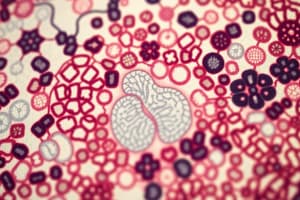Podcast
Questions and Answers
Which type of tissue is characterized by cells that are closely packed together and primarily functions in covering or lining organs?
Which type of tissue is characterized by cells that are closely packed together and primarily functions in covering or lining organs?
- Epithelial tissue (correct)
- Connective tissue
- Muscular tissue
- Nervous tissue
Connective tissue is composed of tightly packed cells that facilitate rapid communication between different parts of the body.
Connective tissue is composed of tightly packed cells that facilitate rapid communication between different parts of the body.
False (B)
What is the primary function of nervous tissue?
What is the primary function of nervous tissue?
To send nerve impulses to muscles, organs, and glands to control them.
To calculate total magnification when using a microscope, you multiply the magnification of the ocular lens by the magnification of the ______ lens.
To calculate total magnification when using a microscope, you multiply the magnification of the ocular lens by the magnification of the ______ lens.
Match each tissue type with its main function:
Match each tissue type with its main function:
When preparing diagrams of cells and tissues observed under a microscope, which of the following guidelines is MOST important for ensuring clarity and accuracy?
When preparing diagrams of cells and tissues observed under a microscope, which of the following guidelines is MOST important for ensuring clarity and accuracy?
Which of the following is the primary characteristic of muscular tissue that enables it to facilitate movement?
Which of the following is the primary characteristic of muscular tissue that enables it to facilitate movement?
Why is it necessary to use a microscope when viewing cells and tissues?
Why is it necessary to use a microscope when viewing cells and tissues?
Flashcards
Four basic tissue types
Four basic tissue types
The four main types of tissue in the human body: epithelial, connective, muscular, and nervous.
Epithelial Tissue
Epithelial Tissue
A tissue made of tightly packed cells that cover surfaces or line organs, providing protection.
Connective Tissue
Connective Tissue
A type of tissue composed of spaced-out cells within a matrix, connecting and supporting other tissues.
Muscular Tissue
Muscular Tissue
Signup and view all the flashcards
Nervous Tissue
Nervous Tissue
Signup and view all the flashcards
Microscope
Microscope
Signup and view all the flashcards
Total Magnification
Total Magnification
Signup and view all the flashcards
Drawing Guidelines for Microscopy
Drawing Guidelines for Microscopy
Signup and view all the flashcards
Study Notes
Viewing Cells and Tissues
-
Tissues in the human body perform specific tasks and are categorized into four main types: epithelial, connective, muscular, and nervous.
-
Microscopy techniques are used for the collection of valid and reliable data in scientific investigations.
-
All living organisms are made up of cells that work together for structure and function.
-
Cells make up tissues, tissues make up organs, and organs make up body systems.
Tissue Types
-
Tissues are composed of multiple similar cells that work together to perform a specific task.
-
Four main tissue types are epithelial, connective, muscular, and nervous.
Epithelial Tissue
-
Epithelial tissue is made up of tightly packed epithelial cells.
-
Its function is to cover the outside of the body and line the inside of organs.
-
It protects underlying structures and carries out absorption and secretion.
-
Simple squamous, stratified squamous, simple cuboidal, stratified cuboidal, simple columnar, and stratified columnar are different types of epithelial tissue, each with its specific structure and function.
Connective Tissue
-
Connective tissue consists of widely spaced cells surrounded by a matrix.
-
Its function is to connect and support various tissue types and organs while providing structure.
-
Types include loose connective tissue (under the skin), adipose tissue (fat), blood, fibrous connective tissue (forming ligaments), cartilage, and bone.
Muscular Tissue
-
Muscular tissue is made up of long, thin, closely associated muscle cells.
-
The cells communicate with each other to coordinate movement.
-
Types include skeletal muscle, cardiac muscle, and smooth muscle.
Nervous Tissue
-
Nervous tissue is made up of star-shaped nerve cells called neurons.
-
Nervous tissue sends nerve impulses to muscles, organs, and glands to regulate body functions.
-
The brain and spinal cord are examples of nervous tissue.
Viewing Cells and Tissues with Microscopes
-
Microscopes use a series of lenses to magnify objects and make them easier to view. Cells and tissues are too small to see with the naked eye.
-
Microscopy is essential in studies of tissues and cells.
Microscope Parts
- Ocular lens (eyepiece)
- Objective lens
- Revolving nosepiece
- Body tube
- Stage clips
- Diaphragm
- Light source
- Stage
- Coarse adjustment knob
- Fine adjustment knob
- Arm
- Base
Magnification
- Ocular lens magnifies the image.
- Objective lens magnifies the image.
- Total magnification is the product of ocular and objective magnifications.
Drawing Techniques
- Use a pencil for diagrams.
- Neat and ruled lines should be used and lines should not overlap.
- Labels should be placed on the right side of diagram.
- No arrows on the diagram.
- Each diagram should occupy at least half a page.
- Magnification should be at the bottom of the diagram.
- Descriptive title under the drawing.
Studying That Suits You
Use AI to generate personalized quizzes and flashcards to suit your learning preferences.
Related Documents
Description
Explore the organization of cells into tissues, organs, and systems. Learn about the four main tissue types: epithelial, connective, muscular, and nervous. Discover the function of Epithelial tissue. Includes microscopy techniques to view the cells.




